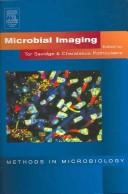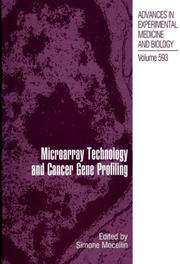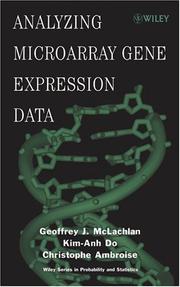| Listing 1 - 10 of 40 | << page >> |
Sort by
|
Book
Year: 2017 Publisher: Bruxelles: UCL. Faculté de pharmacie et des sciences biomédicales,
Abstract | Keywords | Export | Availability | Bookmark
 Loading...
Loading...Choose an application
- Reference Manager
- EndNote
- RefWorks (Direct export to RefWorks)
Actuellement, le diagnostic d'infections sur des prélèvements en routine clinique se fait par méthodes conventionnelles (coloration de Gram, cultures) avec comme inconvénient majeur, un délai de résultat de 1 à 2 jours en moyenne. L'émergence de méthodes par spectrométrie de masse couplées à une source d'ionisation (MALDI-TOF) ou encore de méthodes par immunoassays ont permis de réduire ce temps d'analyse. Ces dernières années, les recherches se sont également intensifiées dans le domaine de la biologie moléculaire, avec les PCR notamment. Dans ce travail seront traitées les microarrays, une méthode par biologie moléculaire se basant sur l'hybridation entre une cible (acides nucléiques) et une sonde spécifique. Sur base de nombreuses études réalisées sur cette technologie, les performances de différentes microarrays (qu'elles soient commercialisées ou non) ont ainsi été comparées, en fonction de la pathologie suspectée (infections du tractus respiratoire, du système nerveux central, du tractus digestif, du sang, du système ostéo-articulaire ou du système urinaire). La rapidité d'analyse (moins de 5 heures en moyenne) est un atout majeur de cette technologie permettant ainsi une prise en charge adéquate du patient infecté. En matière de performance, les microarrays ont une sensibilité similaire aux méthodes par culture, et ont une excellente spécificité, mais le multiplexage offre l'avantage d'analyser simultanément plusieurs pathogènes sur le même échantillon en même temps. Actuellement, les limitations de ces microarrays résultent en leur absence de détection de certains germes (non-inclus dans les panels de détection) ainsi que leur coût d'analyse élevé. Cependant, certaines études ont mis en avant le potentiel économique de certains kits lors de leur implémentation en routine clinique. Il faudrait donc réaliser de plus amples études à plus large échelle pour analyser le réel impact économique d'une éventuelle implémentation de ces panels en routine clinique. Currently, the diagnosis of an infected routine sample is made by conventional methods (Gram stains, cultures) which bears one major inconvenient: a 1 to 2 days average delay for results. The emergence of methods using spectrometry coupled with a source of ionization (MALDI-TOF) or Immunoassay have now made it possible to reduce the analysis’ time. Over past few years, research has been intensified in the field of molecular biology, especially with PCR analysis. This work will cover microarrays, a molecular method using hybridation between a target (nucleic acids) and a specific primer. Based on numerous studies, these different types of microarrays (commercialized or not) were compared according to the suspected pathology (respiratory tract, central nervous system, gastrointestinal, blood, osteo-articular system, or urinary tract). The time of analysis (less than 5 hours on average) is a major advantage for this technology which allows a rapid and appropriate care of patient. In terms of performance, microarrays have a sensitivity that is comparable to methods by culture and have excellent specificity but multiplexing allows a simultaneous analysis of different pathogens on the same sample. Nowadays, microarrays remain limited by their inability to detect certain pathogens (not included in the detection panels) as well as its cost. However certain studies have shown results of economic benefits when certain kits are used in routine clinics. Further studies should be carried on a broader scale to analysis the real economic impact of a potential implementation of these panels in routine clinics.
Diagnostic Techniques and Procedures --- Microarray Analysis
Periodical
Abstract | Keywords | Export | Availability | Bookmark
 Loading...
Loading...Choose an application
- Reference Manager
- EndNote
- RefWorks (Direct export to RefWorks)
DNA microarrays --- Protein microarrays --- Gene expression --- Microarray Analysis --- methods. --- instrumentation.
Book
Abstract | Keywords | Export | Availability | Bookmark
 Loading...
Loading...Choose an application
- Reference Manager
- EndNote
- RefWorks (Direct export to RefWorks)
Dna microarrays --- Dna --- Genetic phenomena --- Genome --- Genomics --- Microarray analysis --- Analysis --- Methods
Periodical
Abstract | Keywords | Export | Availability | Bookmark
 Loading...
Loading...Choose an application
- Reference Manager
- EndNote
- RefWorks (Direct export to RefWorks)
DNA microarrays --- Protein microarrays --- Gene expression --- DNA microarrays. --- Gene expression. --- Protein microarrays. --- Microarray Analysis --- methods. --- instrumentation.
Periodical
Abstract | Keywords | Export | Availability | Bookmark
 Loading...
Loading...Choose an application
- Reference Manager
- EndNote
- RefWorks (Direct export to RefWorks)
DNA microarrays --- Protein microarrays --- Gene expression --- DNA microarrays. --- Gene expression. --- Protein microarrays. --- Microarray Analysis --- methods. --- instrumentation.
Periodical
ISSN: 25715135 Year: 2017 Publisher: Basel, Switzerland : MDPI,
Abstract | Keywords | Export | Availability | Bookmark
 Loading...
Loading...Choose an application
- Reference Manager
- EndNote
- RefWorks (Direct export to RefWorks)
Sequence Analysis --- Microarray Analysis --- Informatics. --- instrumentation. --- high-dimensional approaches --- life sciences --- DNA Sequencing --- bioinformatics --- dna sequencing --- Information science
Book
ISBN: 1617379700 1617379697 9781617379703 Year: 2011 Publisher: Totowa, NJ Humana Press :Imprint: Humana
Abstract | Keywords | Export | Availability | Bookmark
 Loading...
Loading...Choose an application
- Reference Manager
- EndNote
- RefWorks (Direct export to RefWorks)
As a high throughput method for analyzing gene function, cell-based microarrays have proven to be of vital importance, allowing high throughput analysis of over expression and knock down of proteins. In Cell-Based Microarrays: Methods and Protocols, experts in the field provide an up to date synopsis of cell-based microarrays and meticulous coverage of all aspects of the array, including emerging technology. Beginning with a detailed overview of the whole subject area, the volume continues with protocols for over-expression arrays and downstream functional assays, infectious disease research, increasing transfection efficiencies, as well as the development of cell-based array technology by use of microfluidic image cytometry for the analysis of small diagnostic samples with few cells. Written in the highly successful Methods in Molecular Biology™ series format, chapters include introductions to their respective topics, lists of the necessary materials and reagents, step-by-step, readily reproducible laboratory protocols, and notes on troubleshooting and avoiding known pitfalls. Comprehensive and cutting-edge, Cell-Based Microarrays: Methods and Protocols serves as a key resource for molecular biologists, geneticists, immunologists, and chemists, and supplies scientists with access to set up a technology that is truly high throughput for the functional analysis of proteins.
Cytology. --- Cell Biology. --- Cell biology --- Cellular biology --- Biology --- Cells --- Cytologists --- Biochips. --- Microchip Analytical Procedures. --- Technology, Pharmaceutical. --- Microarray Analysis. --- High-Throughput Screening Assays. --- Chemistry Techniques, Analytical. --- Investigative Techniques.

ISBN: 0125215347 Year: 2005 Publisher: Amsterdam : Elsevier Academic Press,
Abstract | Keywords | Export | Availability | Bookmark
 Loading...
Loading...Choose an application
- Reference Manager
- EndNote
- RefWorks (Direct export to RefWorks)
BACTERIA --- INVESTIGATIVE TECHNIQUES --- FLUOROMETRY --- MICROSCOPY --- RADIONUCLIDE IMAGING --- TOMOGRAPHY --- MOLECULAR PROBE TECHNIQUES --- BIOSENSING TECHNIQUES --- POLYMERASE CHAIN REACTION --- MICROARRAY ANALYSIS --- ISOLATION AND PURIFICATION

ISBN: 1441922989 0387399771 9786611336707 128133670X 038739978X Year: 2007 Publisher: New York, N.Y. : Austin, Tex. : Springer Science+Business Media ; Landes Bioscience/Eurekah.com,
Abstract | Keywords | Export | Availability | Bookmark
 Loading...
Loading...Choose an application
- Reference Manager
- EndNote
- RefWorks (Direct export to RefWorks)
Cancer is a heterogeneous disease in most respects, including its cellularity, different genetic alterations and diverse clinical behaviors. Traditional molecular analyses are reductionist, assessing only one or a few genes at a time, thus working with a biologic model too specific and limited to confront a process whose clinical outcome is likely to be governed by the combined influence of many genes. The potential of functional genomics is enormous, because for each experiment, thousands of relevant observations can be made simultaneously. Accordingly, DNA array, as other high throughput technologies, might catalyze and ultimately accelerate the development of knowledge in tumor cell biology. Although in its infancy, the implementation of DNA array technology in cancer research has already provided investigators with novel data and intriguing new hypotheses on the molecular cascade leading to cancerogenesis, tumor aggressiveness and sensitivity to antineoplastic agents. Given the revolutionary implications that the use of this technology might have in the clinical management of cancer patients, principles of DNA array-based tumor gene profiling need to be clearly understood for the data to be correctly interpreted and appreciated. In the present book, written by leading experts in each field, the technical features characterizing this powerful laboratory tool are discussed, and the applications so far described in the field of oncology are reviewed.
DNA microarrays. --- Gene Expression Profiling -- methods. --- Microarray Analysis -- methods. --- Neoplasms -- genetics. --- Oncogenes. --- Medicine --- Health & Biological Sciences --- Oncology --- Oncogenes --- DNA microarrays --- Gene Expression Profiling --- Microarray Analysis --- Methods --- Neoplasms --- Genetics --- Biology --- Genetic Techniques --- Microchip Analytical Procedures --- Diseases --- Investigative Techniques --- Chemistry Techniques, Analytical --- Biological Science Disciplines --- Analytical, Diagnostic and Therapeutic Techniques and Equipment --- Natural Science Disciplines --- Disciplines and Occupations --- DNA biochips --- Microarrays, DNA --- Onc genes --- Medicine. --- Cancer research. --- Oncology. --- Medicine & Public Health. --- Cancer Research. --- Tumors --- Cancer research --- Clinical sciences --- Medical profession --- Human biology --- Life sciences --- Medical sciences --- Pathology --- Physicians --- Biochips --- Immobilized nucleic acids --- Cancer genes --- Proto-oncogenes --- Oncology .

ISBN: 0471226165 9780471226161 Year: 2004 Publisher: Hoboken: Wiley,
Abstract | Keywords | Export | Availability | Bookmark
 Loading...
Loading...Choose an application
- Reference Manager
- EndNote
- RefWorks (Direct export to RefWorks)
Mathematical statistics --- Oligonucleotide Array Sequence Analysis --- Gene Expression Profiling --- DNA microarrays --- Gene expression --- Puces à ADN --- Expression génique --- methods --- Statistical methods --- Méthodes statistiques --- Statistical methods. --- Genetic Techniques. --- DNA microarrays - Statistical methods. --- Gene expression - Statistical methods. --- Genetic Techniques --- Microarray analysis --- Molecular probe techniques
| Listing 1 - 10 of 40 | << page >> |
Sort by
|

 Search
Search Feedback
Feedback About UniCat
About UniCat  Help
Help News
News